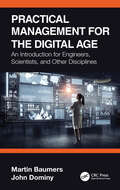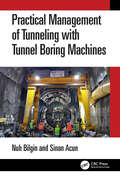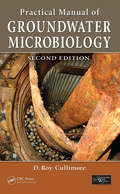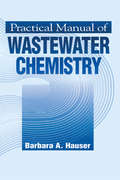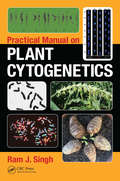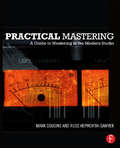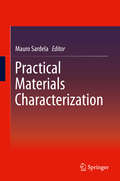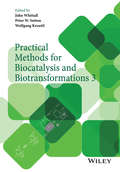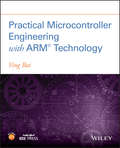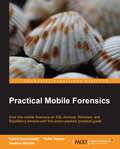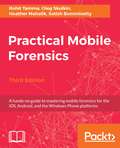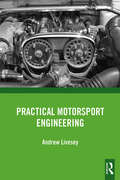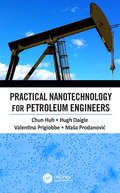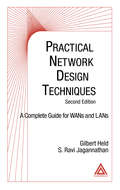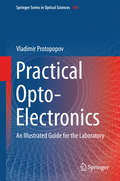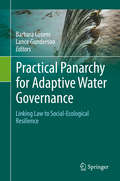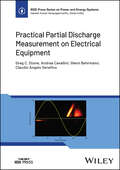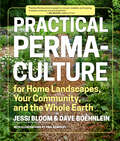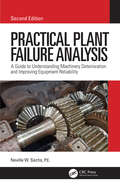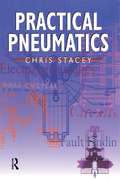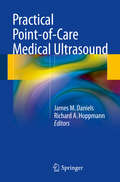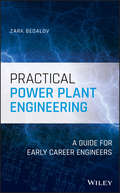- Table View
- List View
Practical Management for the Digital Age: An Introduction for Engineers, Scientists, and Other Disciplines
by Martin Baumers John DominyPractical Management for the Digital Age is an innovative introductory management textbook that shows the sweeping impact of information technology on the business world. At the same time, it addresses the pressing issue of how environmental aspects are interwoven with management decisions. This book forms an academically rigorous, accurate, and accessible first exposure to a topic that often challenges novices with competing definitions, inconsistent use of terminology, methodological variety, and conceptual fuzziness. It has been written for readers with little or no prior knowledge of management and is compact enough to be read cover-to-cover over the course of a semester. Features of this book: Provides a broad, self-contained treatment of management for those without prior knowledge of management or commerce, emphasizing core ideas that every manager should know. Establishes the context of modern management by characterizing the nature of the private enterprise, the economic theory of the firm, the economics of digitalization and automation, processes of innovation, and life cycle thinking. Introduces readers to various activities of managing, including business modeling, new business formation, operations management, managing people, marketing, and the management of quality and risk. Provides practical introductions to broadly applied management techniques, including financial planning, financial analysis, evaluating flows of money, and planning and monitoring projects. This book is aimed at a wide range of undergraduate and postgraduate students in a variety of disciplines, as well as practitioners. It will be especially useful to those in the fields of engineering, science, computer science, medicine, pharmacy, social sciences, and more. It will help student readers engage confidently with project work in the final parts of their degree courses and, most importantly, with managerial situations later in their careers. For instructors, who may not have a management background, this book offers content for a self-contained year-long course in management at the intermediate undergraduate level. In addition, it has been developed for undergraduate and postgraduate courses with accreditation requirements that include a taught element in management, such as the UK Engineering Council’s Accreditation of Higher Education (AHEP) framework.
Practical Management of Tunneling with Tunnel Boring Machines
by Nuh Bilgin Sinan AcunThis book covers the management of mechanized tunneling with examples from global projects. It starts with an introduction to mechanized tunneling including management of job organization, planning job sites, portals, or launching boxes in mountains/open fields and urban areas. The management of the transport with belt conveyors, locomotives, and multi-service vehicles is explained with numerical examples. Cost management and basic parameters governing tunneling costs in different countries are discussed. Risk management in mechanized tunneling projects is also explained. Features: Offers the practical issues with setting up a job site, the cost, and logistic issues related to tunneling. Reviews cost management and basic parameters governing tunneling costs in different countries. Covers treatment of spoil management plan and the management of contaminated ground. Explores key points on the logistics and the management of the consumables. Provides the latest international case studies of specific companies. This book is aimed at professionals and researchers in tunneling, civil and mining engineering, and geology.
Practical Manual of Groundwater Microbiology (Sustainable Water Well)
by D. Roy CullimoreAlthough microorganisms can be found virtually anywhere on our planet, from clouds to soils to oceans, they are often poorly understood when examining issues related to groundwater and water wells. Focusing on the impact of microorganisms on groundwater and water wells, Practical Manual of Groundwater Microbiology, Second Edition presents ov
Practical Manual of Wastewater Chemistry
by Barbara HauserThis manual is prepared to enhance the wastewater treatment plant operator's understanding of laboratory theory and procedure in the testing of wastewater, to appreciate the nature of the contaminants under analysis, the analytical methods, and their limitations.
Practical Manual on Plant Cytogenetics
by Ram J. SinghEarlier books on the handling of plant chromosomes have not included many of the innovations in cytological techniques for many important crops that have become available in recent years, including information on associating genes with chromosomes. The aim of this book is to compile all the plant cytogenetic techniques, previously published in earlier books, into a laboratory manual. The first part of the book describes standard cytological techniques that are routinely used by students. The second part covers methods used for specific crops for which common cytological methods do not work satisfactorily. The third part discusses cytogenetic techniques (cytology and genetics) for physically locating genes on specific chromosomes. This novel book will be highly useful to students, teachers, and researchers as it is a convenient and comprehensive reference for all plant cytogenetic techniques and protocols.
Practical Mastering: A Guide to Mastering in the Modern Studio
by Mark Cousins Russ Hepworth-SawyerGuiding you through the history and emergence of modern mastering techniques, then providing practical hints and tips on how to use them in your set up, Practical Mastering is the book for anyone interested in tackling this elusive art form. Providing you with sold mastering theory underpinned by years of professional experience and hands-on advice for getting the most out of your set up while honing your ears to efficiently and effectively listen to your mixes in order to create perfectly polished master tracks.
Practical Materials Characterization
by Mauro SardelaPractical Materials Characterization covers the most common materials analysis techniques in a single volume. It stands as a quick reference for experienced users, as a learning tool for students, and as a guide for the understanding of typical data interpretation for anyone looking at results from a range of analytical techniques. The book includes analytical methods covering microstructural, surface, morphological, and optical characterization of materials with emphasis on microscopic structural, electronic, biological, and mechanical properties. Many examples in this volume cover cutting-edge technologies such as nanomaterials and life sciences.
Practical Methods for Biocatalysis and Biotransformations 2
by Peter Sutton John WhittallBiocatalysts are increasingly used by chemists engaged in fine chemical synthesis within both industry and academia. Today, there exists a huge choice of high-tech enzymes and whole cell biocatalysts, which add enormously to the repertoire of synthetic possibilities.Practical Methods for Biocatalysis and Biotransformations 2 is a "how-to" guide that focuses on the practical applications of enzymes and strains of microorganisms that are readily obtained or derived from culture collections. The sources of starting materials and reagents, hints, tips and safety advice (where appropriate) are given to ensure, as far as possible, that the procedures are reproducible. Comparisons to alternative methodology are given and relevant references to the primary literature are cited. This second volume - which can be used on its own or in combination with the first volume - concentrates on new applications and new enzyme families reported since the first volume. Contents include:introduction to recent developments and future needs in biocatalysts and synthetic biology in industryreductive aminationenoate reductases for reduction of electron deficient alkenesindustrial carbonyl reductionregio- and stereo- selective hydroxylationoxidation of alcoholsselective oxidationindustrial hydrolases and related enzymestransferases for alkylation, glycosylation and phosphorylationC-C bond formation and decarboxylationhalogenation/dehalogenation/heteroatom oxidationtandem and sequential multi-enzymatic synthesesPractical Methods for Biocatalysis and Biotransformations 2 is an essential collection of biocatalytic methods for chemical synthesis which will find a place on the bookshelves of synthetic organic chemists, pharmaceutical chemists, and process R&D chemists in industry and academia.
Practical Methods for Biocatalysis and Biotransformations 3
by John Whittall Wolfgang Kroutil Peter W. SuttonBiocatalysts are increasingly used by chemists engaged in fine chemical synthesis within both industry and academia. Today, there exists a huge choice of high-tech enzymes and whole cell biocatalysts, which add enormously to the repertoire of synthetic possibilities. Practical Methods for Biocatalysis and Biotransformations 3 will be a companion book to Practical Methods for Biocatalysis and Biotransformations (2009) and Practical Methods for Biocatalysis and Biotransformations 2 (2012). Following the successful format of the two volumes, it will be a "how-to" guide focusing on commercially available enzymes and strains of microorganisms that are readily obtained from culture collections. The source of starting materials and reagents, hints, tips and safety advice (where appropriate) will be given to ensure, as far as possible, that the procedures are reproducible. Comparisons to alternative methodology will be given and relevant references to the primary literature will be cited. Contents include: Biotransformation Process Technology Industrial Biooxidation Hydrolase catalysed hydrolysis/synthesis Reduction Oxidation Halogenation Transferase catalysed glycosylation, methylation, etc C-C bond formation Tandem Biocatalytic Reactions Practical Methods for Biocatalysis and Biotransformations, Volume 3 is an essential collection of validated biocatalytic methods which will find a place on the bookshelves of synthetic organic chemists, pharmaceutical chemists, and process R&D chemists in industry and academia.
Practical Microcontroller Engineering with ARM Technology
by Ying BaiThis book covers both the fundamentals, as well as practical techniques in designing and building microcontrollers in industrial and commercial applications. Examples included in this book have been compiled, built, and tested Includes Both ARM® assembly and C codes Direct Register Access (DRA) model and the Software Driver (SD) model programming techniques and discussed If you are an instructor and adopted this book for your course, please email ieeeproposals@wiley. com to get access to the instructor files for this book.
Practical Mobile Forensics
by Rohit Tamma Heather Mahalik Satish BommisettyThe book is an easy-to-follow guide with clear instructions on various mobile forensic techniques. The chapters and the topics within are structured for a smooth learning curve, which will swiftly empower you to master mobile forensics. If you are a budding forensic analyst, consultant, engineer, or a forensic professional wanting to expand your skillset, this is the book for you. The book will also be beneficial to those with an interest in mobile forensics or wanting to find data lost on mobile devices. It will be helpful to be familiar with forensics in general but no prior experience is required to follow this book.
Practical Mobile Forensics - Third Edition: A Hands-on Guide To Mastering Mobile Forensics For The Ios, Android, And The Windows Phone Platforms
by Rohit TammaMobile phone forensics is the science of retrieving data from a mobile phone under forensically sound conditions. This book is an update to Practical Mobile Forensics, Second Edition and it delves into the concepts of mobile forensics and its importance in today’s world.
Practical Models of Antenna Systems (Springer Aerospace Technology)
by Amur B. Khashimov Rinat R. SalikhovThis book discusses the principles of forming and analysis of mathematical models of a wide class of antenna systems, new scientific directions in the development and application of computational algorithms for the study of mathematical models for antenna arrays of radio navigating systems. The book is presented for specialists in antenna system design; it may be useful for students of radio engineering specialties. This book consequentially uses the asymptotic correspondence of two-dimensional and three-dimensional problems to antenna engineering, that includes the influence of the placement objects for a given limited class of problems. Rigorous electrodynamics formulations of models and the use of efficient numerical methods provide the reliability and accuracy of modeling.
Practical Motorsport Engineering
by Andrew LiveseyThis guide and textbook on motorsport engineering is written from a practical point of view. It offers a wide-ranging insight into the nuts and bolts technology of practical car racing from saloons and sports cars to open wheelers. It gives the aspiring race engineer the tools to do the job by explaining all aspects of race car technology and offering crucial insight into the essentials of the motorsport engineering industry. For motorsport engineering students at all levels, this book particularly covers the examination syllabuses for IMI (the Institute of the Motor Industry), EAL and BTEC, and meets the CPD requirements of most engineering institutions. Each aspect of the race car is covered in a separate chapter with test questions and suggestions for further study at the end. Combining the key points from his previous publications Basic Motorsport Engineering and Advanced Motorsport Engineering, the author draws on a career in teaching and industry to create the must-have, all-in-one reference. It is an ideal companion for the practising owner, driver or race engineer (whether amateur or professional), a suitable introductory text for HND and degree students and a great point of reference for any other keen fans with an interest in motorsport.
Practical Nanotechnology for Petroleum Engineers
by Chun Huh Hugh Daigle Valentina Prigiobbe Masa ProdanovicThis book is a concise but well-organized introduction to nanotechnology (NT) which the upstream oil industry is now vigorously adapting to develop its own unique applications for improved oilfield operations and, oil and gas production. Its reader will learn nanotechnology fundamentals, be introduced to important NT products and applications from other industries and learn about the current state of development of various NT applications in the upstream oil industry, which include innovative use of nanoparticles for enhanced oil recovery; drilling and completions; reservoir sensing; and production operations and flow assurance. <P><P>Key Features <li>Exclusive title on potential of nanoparticle-based agents and interventions for improving myriad of oilfield operations <li>Unique guide for nanotechnology applications developers and users for oil and gas production <li>Introduces nanotechnology for oil and gas managers and engineers <li>Includes research data discussions relevant to field <li>Offers a practical applications-oriented approach
Practical Network Design Techniques: A Complete Guide For WANs and LANs
by Gilbert Held S. Ravi JagannathanThe authors of Practical Network Design Techniques, Second Edition: A Complete Guide for WANs and LANs build upon the popular first edition by combining pre-existing network design fundamentals with new material on LAN devices and topologies, wireless local networks, and LAN internetworking issues.This new edition has two parts. The first p
Practical Optical Interferometry
by David F. BuscherOptical interferometry is a powerful technique to make images on angular scales hundreds of times smaller than is possible with the largest telescopes. This concise guide provides an introduction to the technique for graduate students and researchers who want to make interferometric observations and acts as a reference for technologists building new instruments. Starting from the principles of interference, the author covers the core concepts of interferometry, showing how the effects of the Earth's atmosphere can be overcome using closure phase, and the complete process of making an observation, from planning to image reconstruction. This rigorous approach emphasizes the use of rules-of-thumb for important parameters such as the signal-to-noise ratios, requirements for sampling the Fourier plane and predicting image quality. The handbook is supported by web resources, including the Python source code used to make many of the graphs, as well as an interferometry simulation framework, available at www. cambridge. org/9781107042179.
Practical Opto-Electronics
by Vladimir ProtopopovThis book explains how to create opto-electronic systems in a most efficient way, avoiding typical mistakes. It covers light detection techniques, imaging, interferometry, spectroscopy, modulation-demodulation, heterodyning, beam steering and many other topics common to laboratory applications. The focus is made on self-explanatory figures rather than on words. The book guides the reader through the entire process of creating problem-specific opto-electronic systems, starting from optical source, through beam transportation optical arrangement, to photodetector and data acquisition system. The relevant basics of beam propagation and computer-based raytracing routines are also explained, and sample codes are listed. the book teaches important know-how and practical tricks that are never disclosed in scientific publications. The book can become the reader's personal adviser in the world of opto-electronics and navigator in the ocean of the market of optical components and systems. Succinct, well-illustrated and clearly written, this book is helpful for students, postgraduates, engineers and researches working not only in the field of applied optics but also in high-tech industry, information technology, medicine, biology and other domains.
Practical Panarchy for Adaptive Water Governance
by Barbara Cosens Lance GundersonThis book presents the results of an interdisciplinary project that examined how law, policy and ecological dynamics influence the governance of regional scale water based social-ecological systems in the United States and Australia. The volume explores the obstacles and opportunities for governance that is capable of management, adaptation, and transformation in these regional social-ecological systems as they respond to accelerating environmental change. With the onset of the Anthropocene, global and regional changes in biophysical inputs to these systems will challenge their capacity to respond while maintaining functions of water supply, flood control, hydropower production, water quality, and biodiversity. Governance lies at the heart of the capacity of these systems to meet these challenges. Assessment of water basins in the United States and Australia indicates that state-centric governance of these complex and dynamic social-environmental systems is evolving to a more complex, diverse, and complex array public and private arrangements. In this process, three challenges emerge for water governance to become adaptive to environmental change. First, is the need for legal reform to remove barriers to adaptive governance by authorizing government agencies to prepare for windows of opportunity through adaptive planning, and to institutionalize the results of innovative solutions that arise once a window opens. Second, is the need for legal reform to give government agencies the authority to facilitate and participate in adaptive management and governance. This must be accompanied by parallel legal reform to assure that engagement of private and economic actors and the increase in governmental flexibility does not destabilize basin economies or come at the expense of legitimacy, accountability, equity, and justice. Third, development of means to continually assess thresholds and resilience of social-ecological systems and the adaptive capacity of their current governance to structure actions at multiple scales. The massive investment in water infrastructure on the river basins studied has improved the agricultural, urban and economic sectors, largely at the cost of other social and environmental values. Today the infrastructure is aging and in need of substantial investment for those benefits to continue and adapt to ongoing environmental changes. The renewal of institutions and heavily engineered water systems also presents the opportunity to modernize these systems to address inequity and align with the values and objectives of the 21st century. Creative approaches are needed to transform and modernize water governance that increases the capacity of these water-based social-ecological systems to innovate, adapt, and learn, will provide the tools needed to navigate an uncertain future.
Practical Partial Discharge Measurement on Electrical Equipment (IEEE Press Series on Power and Energy Systems)
by Greg C. Stone Andrea Cavallini Glenn Behrmann Claudio Angelo SerafinoPractical Partial Discharge Measurement on Electrical Equipment Accessible reference dealing with (partial discharge) PD measurement in all types of high voltage equipment using modern digital PD detectors Practical Partial Discharge Measurement on Electrical Equipment is a timely update in the field of partial discharges (PD), covering both holistic concepts and specific modern applications in one volume. The first half of the book educates the reader on what PD is and the general principles of how it is measured and interpreted. The second half of the book is similar to a handbook, with a chapter devoted to PD measurements in each type of high voltage (HV) equipment. These chapters contain specific information of the insulation system design, causes of PD in that equipment, off-line and on-line measurement methods, interpretation methods, and relevant standards. The work is authored by four well-known experts in the field of PD measurement who have published hundreds of technical papers on the subject and performed thousands of PD measurements on all the different types of HV equipment covered in the book. The authors have also had relationships with PD detector manufacturers, giving them key insights into test instruments and practical measurements. Sample topics covered in the work include: Physics of PD, discharge phenomena (contact sparking and vibration sparking), and an introduction to PD measurement (electrical, optical, acoustic, and chemical) Electrical PD detection (types of sensors), RF PD detection (antenna, TEV), and PD instrumentation and display Off-line and on-line PD measurements, general principles of PD interpretation, and laboratory PD testing of lumped test objects PD in different types of HV equipment (power cables, power transformers, air insulated metal-clad switchgear, rotating machines, gas-insulated switchgear, and more) For HV equipment OEMs, users of HV equipment, or employees of companies that provide PD testing services to clients, Practical Partial Discharge Measurement on Electrical Equipment is an essential reference to help understand general concepts about the topic and receive expert guidance during specific practical applications.
Practical Permaculture: for Home Landscapes, Your Community, and the Whole Earth
by Jessi Bloom Dave Boehnlein Mr Paul Kearsley“Practical Permaculture is powerful, visceral, readable, and inspiring. It shows us how we can and should live.” —Joel Salatin, farmer and author Jessi Bloom and Dave Boehnlein, two dynamic leaders in the permaculture community, offer authoritative, in-depth, hands-on advice that shares a holistic approach to sustainable living. Permaculture is a growing trend, but still a daunting concept to many. New to permaculture principles and techniques? The guesswork will be eliminated by paging through this invaluable resource. Already an expert? This guide will surely make an important addition to your sustainable agriculture reference shelf.
Practical Plant Failure Analysis: A Guide to Understanding Machinery Deterioration and Improving Equipment Reliability, (Mechanical Engineering)
by P. E. Neville W SachsThis is a practical guide for those who do the work of maintaining and improving the reliability of mechanical machinery. It is for engineers and skilled trades personnel who want to understand how failures happen and how the physical causes of the great majority can be readily diagnosed in the field. It explains the four major failure mechanisms, wear, corrosion, overload, and fatigue and, using easy-to-read charts, how they can be diagnosed at the site of the failure. Then, knowing the physical failure mechanics involved, the reader can accurately solve the human causes. To improve the reader’s understanding, all the diagrams and most of the tables have been redrawn. The number of actual failure examples has been increased, plus the last chapter on miscellaneous machine elements includes new material on couplings, universal joints, and plain bearings. Features: A practical field guide showing how to recognize how failures occur that can be used to solve more than 85% of mechanical machinery failures, Incorporates multiple easy-to-follow logic trees to help the reader diagnose the physical causes of the failure without needing detailed laboratory analysis, and Explains how the mechanics, corrosion, materials science, and tribology of components can fit together to improve machinery reliability. Includes more than 150 completely redrawn charts and tables, plus almost 250 actual failure photographs to help guide the reader to an accurate analysis Contains clear and detailed explanations of how lubricants function and the critical roles of corrosion and lubrication play in causing mechanical failures
Practical Pneumatics
by Chris StaceyPneumatic power is ideal for the ever increasing range of 'light' applications in which a cheap, clean, adaptable source of power is needed. Used in conjunction with microprocessor control it forms the basis of manufacturing automation from basic conveying and handling lines to complex robotic assembly systems. Training courses and books aimed at the technician have not kept pace with these developments. This book is written to cover the British Fluid Power Association Pneumatics Certificate, which is also awarded as part of CGLI scheme 2340, and is in the process of NVQ accreditation at level 3. 'Practical Pneumatics' provides a clear and detailed discussion of pneumatic technology by tackling the principles of pneumatic components and the behaviour of air under compression, during treatment and in applications to production processes. The non-mathematical approach, the numerous detailed diagrams and the many exercises and examples explain concepts clearly and concisely and provide students with a foundation from which to develop practical competence.
Practical Point-of-Care Medical Ultrasound
by James M. Daniels Richard A. HoppmannThis book serves as a comprehensive guide for integrating point-of-care ultrasound into clinical care. It includes detailed chapters on the use of ultrasound in cardiology, dermatology, obstetrics and gynecology, and pediatrics, as well as for the assessment of the abdomen, musculoskeletal system, eyes, and thorax. Over the last decade, the use of diagnostic, point-of-care ultrasound at the bedside has been widely adopted by healthcare professionals in the United States. This technology has spread into many new areas of clinical medicine and more non-radiologists are seeking training and an up-to-date resource on use of the ultrasound machine. This book provides guidance on how to best approach patients with particular problems, practical guidelines on how to operate the machine and choose probes, descriptions and illustrations that depict the patient's position and structures that are scanned, and the anatomy and pathophysiology of each area. Practical Point-of-Care Medical Ultrasound is a valuable addition to the library of any resident, fellow, physician, or other healthcare provider who uses ultrasound in a clinical setting.
Practical Power Plant Engineering: A Guide for Early Career Engineers (IEEE PCS Professional Engineering Communication Series)
by Zark BedalovPractical Power Plant Engineering offers engineers, new to the profession, a guide to the methods of practical design, equipment selection and operation of power and heavy industrial plants as practiced by experienced engineers. The author—a noted expert on the topic—draws on decades of practical experience working in a number of industries with ever-changing technologies. This comprehensive book, written in 26 chapters, covers the electrical activities from plant design, development to commissioning. It is filled with descriptive examples, brief equipment data sheets, relay protection, engineering calculations, illustrations, and common-sense engineering approaches. The book explores the most relevant topics and reviews the industry standards and established engineering practices. For example, the author leads the reader through the application of MV switchgear, MV controllers, MCCs and distribution lines in building plant power distribution systems, including calculations of interrupting duty for breakers and contactors. The text also contains useful information on the various types of concentrated and photovoltaic solar plants as well as wind farms with DFIG turbines. This important book: • Explains why and how to select the proper ratings for electrical equipment for specific applications • Includes information on the critical requirements for designing power systems to meet the performance requirements • Presents tests of the electrical equipment that prove it is built to the required standards and will meet plant-specific operating requirements Written for both professional engineers early in their career and experienced engineers, Practical Power Plant Engineering is a must-have resource that offers the information needed to apply the concepts of power plant engineering in the real world.
